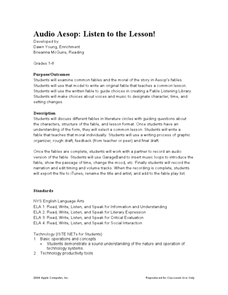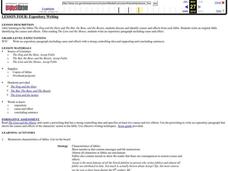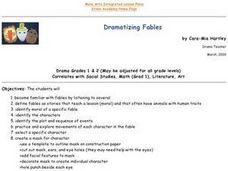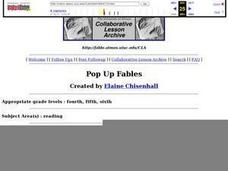Curated OER
Audio Aesop: Listen to the Lesson!
Aesop's Fables are the focus of this language arts instructional activity. Young philosophers study and discuss the morals found in the most famous of Aesop's Fables. They write an original fable that teaches a common moral. A "Fable...
Curated OER
Acting Like a Bunch of Animals: Fables and Human
The video "The Tales of Aesop" traces for viewers the history of fables and identifies their characteristics. The class then goes to the web site "The Fisherman and the Little Fish" where they examine the classic and a modern version of...
Curated OER
Fables and Trickster Tales Around the World
Students analyze fables and trickster tales from various cultural traditions. In this fable analysis lesson plan, students identify the elements of fables and trickster stories. Students read Aesop's fables and Ananse spider stories....
August House
The Contest Between the Sun and the Wind
Learn the moral of the story with a series of activities about Aesop's fables. Focusing on The Contest Between the Sun and the Wind, learners complete a graphic organizer to discuss who, what, how, and why the events occur. Additionally,...
Curated OER
Greek culture and Aesop's Fables
Tenth graders explain political and social thought during the Greek 6th and 5th centuries B.C. They research five to eight fables, figuring out the moral for each and writing an essay on how Aesop influenced the morals and ideals of...
Curated OER
Fable Writing--Inter-disciplinary Approach To Social Sciences
Students recognize the elements of a fable and write an original fable. They make connections with morals and other law-related concepts.
Curated OER
Fable Writing
Students listen to and discuss various fables, and identify the moral and central themes. They write their own personal fables and create illustrations to go with them.
Curated OER
Writing a Fable
Students are introduced to the definition of a fable in that it is a story that has a moral for people to apply in their lives. They then read a fable together so they have a better understanding. Next, students write their own fables.
Curated OER
Kindness Fables
Students create a fable that is based on kindness. In this fables lesson plan, students read and discuss different fables. Then they discuss kindness, and write their own fables based on the kindness of others.
Curated OER
Understanding and Writing Fables
Third graders review with the teacher the characteristics for a fable and what it is. They read one paragraph each from the story, "The Fox and the Stork" aloud. They then answer comprehension questions aloud. Next, they listen to four...
Curated OER
Expository Writing
Write an expository paragraph First, writers first read three fables and identify a cause and effect relationship in the fables. Then, they write their own expository paragraph with a cause and effect relationship. A list of...
Curated OER
Lots of Lessons from Aesop
Aesop’s Fables offer young learners an opportunity to study figurative language. After reviewing theme, simile, alliteration, and metaphor, model for your pupils how to identify examples of these devices in the fable. Class members then...
Curated OER
Greek Culture And Aesop's Fables
Students investigate Aesop's Fables and how they influenced the culture of Ancient Greece. They research five different fables and reflect upon the morals of the stories and state how they influenced the practices of the Greek in writing.
Asian Art Museum
Telling Tales with Kamishibai
Kamishibai (paper drama), is a Japanese form of storytelling that uses emakimono (paper picture scrolls), to relay a moral lesson. As part of a series of resources that examine Japanese art and artists, learners watch a video retelling...
Curated OER
Dramatizing Fables
Students familiarize themselves with fables by listening to several of them. They define fables. They identify the moral of a specific fable. They identify characters, plot and sequence of events. They create a mask of a character in a...
Curated OER
A Fish Tale Fable
Students identify the moral in a fable. In this folktale lesson, students read an included book, Fish Tale, and identify the message in the book. Students discuss what kind of lessons can be learned from reading this fable.
Curated OER
Latino Folklore and Culture: Stories of Family, Traditions of Pride
Learners define the terms fable and folktale. They write a fable to illustrate a Latino proverb. Students are explained that a folktale is a story passed down through the oral tradition of a particular culture. A fable is a type of...
Curated OER
All About Aesop
First graders explore the genre of fables. In this fables lesson, 1st graders use various reading strategies to raise comprehension skills. Students make prediction and complete a prediction journal. Students understand that fables have...
Curated OER
And the Moral of the Story is...
Students retell a story using computer software. In this story elements lesson, students retell the story giving the plot, setting, characters and moral using Pixie software.
Curated OER
Pop Up Fables
Young scholars read a fable and create a pop-up book of the fable. Students add the moral of the story to the back of the book.
Curated OER
Fables With Dolch Sight Words
Second graders read classic fables, consider their meaning and then re-write them using a prompt if necessary. This lesson plan presents many classic fables that students can read, and re-write, using their powers of imagination.
Curated OER
Aesop's Fables
Students read a fable about a lion and a mouse. They discuss the differences between the two animals. As a class, they discover the instructional activity of the story. Then they make puppets and reenact the fable.
Curated OER
The Fable of Franny And Her Fabulous Fainting Goat
Mix the art of reading comprehension with the skill of telling time. Children in grades two and three will discuss the importance of goats throughout history based on the provided background information. They'll create cute goat clocks...
K20 LEARN
Here's How I Heard It: Using Folklore To Improve Close Reading Skills
"X" is for exaggeration, and "F" is for fact. To encourage close reading and to improve literary analysis skills, class members annotate fables and tall tales, like Paul Bunyan, with symbols that identify key features of this genre.

























